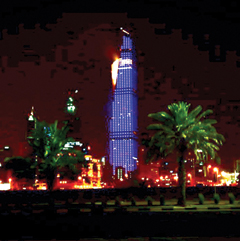 Al-Hamra Tower
Al-Hamra TowerKUWAIT: On June 20, World Refugee Day, Al-Hamra Tower was lit blue to show solidarity with World Refugee Day, an international annual event that commemorates the strength, courage, and resilience of millions of refugees worldwide.
World Refugee Day was first marked in 2001. On this day every year, tens of thousands of people around the world take time to recognize and applaud the contribution of those forced to flee. The annual commemoration is marked by a variety of events in over 100 countries and involves government officials, aid workers, celebrities, civilians, and the forcibly displaced themselves.
Kuwait: International Humanitarian Center
As Kuwait was designated by the United Nations as the International Humanitarian Center, it is taking the initiative and celebrating such an important event by raising awareness and organizing several events. One of these events is lighting Al-Hamra Tower, since it is considered to be one of the most important landmarks in Kuwait.
Blue was chosen to light the tower as an international symbol of the United Nations High Commissioner for Refugees (UNHCR), the UN organization that oversees refugees around the world. The UN High Commissioner for Refugees, Filippo Grandi, said in his statement on World Refugee Day that, "Today the number, complexity and protracted nature of today's conflicts mean that forced displacement has now reached a level unprecedented since the founding of the UN itself; substantially over 60 million people are now uprooted around the world."
Grandi continued, "An historic United Nations General Assembly high-level meeting on addressing large movements of refugees and migrants on the 19th of September will put us all to the test. ...UNHCR stands together #WithRefugees, on World Refugee Day and every day - and on 19 September we want the world to stand with us. By doing so we can send a message to world leaders they must act."
More than 65million people forcibly displaced
UNHCR's annual Global Trends report, which tracks forced displacement worldwide based on data from governments, partners including the Internal Displacement Monitoring Centre, and the organization's own reporting, said 65.3 million people were displaced as of the end of 2015, compared to 59.5 million just twelve months earlier. This is the first time that the threshold of 60 million has been crossed.
Measured against the earth's 7.349 billion population these numbers mean that 1 in every 113 people globally is now either an asylum-seeker, internally displaced or a refugee - a level of risk for which UNHCR knows no precedent. In all, there are more forcibly displaced people today than the populations of the United Kingdom, France or Italy.
Among countries covered by the Global Trends report several stand out: Syria at 4.9 million, Afghanistan at 2.7 million and Somalia at 1.1 million together accounted for more than half the refugees under UNHCR's mandate worldwide.
Danger to children
Children constituted 51 per cent of the world's refugees in 2015 according to the data UNHCR was able to gather (complete demographic data was not available to the report authors). Worryingly, many were separated from their parents or travelling alone. In all there were 98,400 asylum requests from children who were unaccompanied or separated from their families. This is the highest total UNHCR has seen - and a tragic reflection of how global forced displacement is disproportionately affecting young lives.
Syria's war remained the world's leading cause of displacement and associated suffering. By the end of 2015 it had driven at least 4.9 million people into exile as refugees and displaced 6.6 million internally - amounting to around half Syria's pre-war population. Iraq's conflict had by year's end displaced 4.4 million people internally and created more than a quarter of a million refugees. - UNHCR










